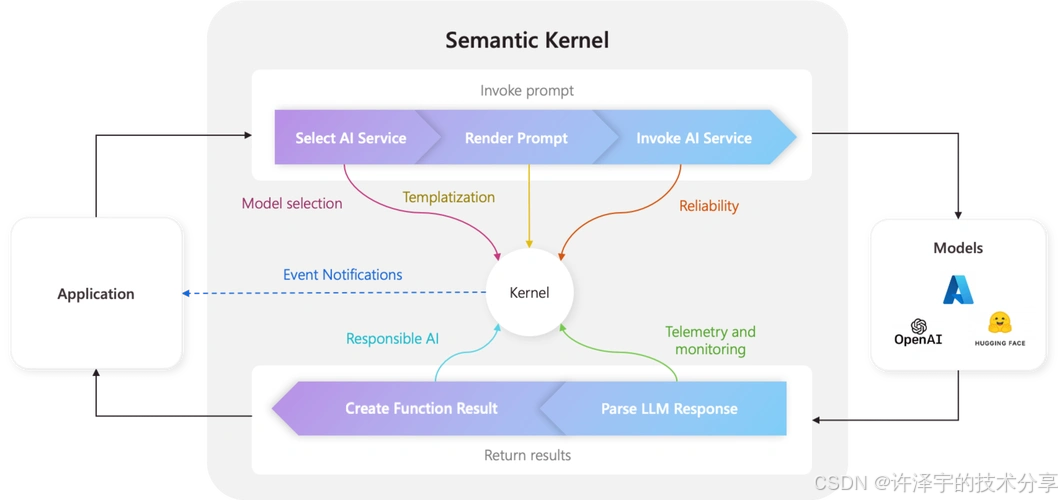多智能体编排之王:深度解析微软Semantic Kernel的AgentOrchestration架构革命
"在AI多智能体时代,如何让群体智慧超越个体智能?微软Semantic Kernel给出了一个让人眼前一亮的答案。"
引言:编排的艺术与智能体的协奏曲
想象一下,你正在指挥一个由不同专业AI智能体组成的"数字交响乐团"——有专门处理自然语言的语言学家智能体,有善于数据分析的统计学家智能体,还有精通逻辑推理的哲学家智能体。如何让这些"乐手"协调配合,演奏出完美的AI交响曲?
这正是微软Semantic Kernel中AgentOrchestration要解决的核心问题。作为.NET生态中最具前瞻性的多智能体编排框架,它不仅仅是技术工具,更是AI应用架构设计的一次革命性探索。
在这篇深度技术解析中,我们将揭开AgentOrchestration的神秘面纱,探索其背后的设计哲学、核心架构、技术实现,以及在实际项目中的应用策略。无论你是.NET开发者、AI架构师,还是对多智能体系统感兴趣的技术探索者,这篇文章都将为你打开一扇通往智能体协作新世界的大门。
第一章:架构哲学——从单体智能到群体协作
1.1 设计理念的哲学思考
AgentOrchestration的设计哲学体现了软件架构的三个核心原则:
解耦与组合:通过抽象基类AgentOrchestration<TInput, TOutput>实现了编排逻辑与具体智能体实现的完全解耦。这种设计让我们可以像搭积木一样组合不同的智能体。
public abstract partial class AgentOrchestration<TInput, TOutput>
{protected AgentOrchestration(params Agent[] members){// 捕获编排根名称,去除泛型参数,用于智能体类型和主题格式化以及日志记录this.OrchestrationLabel = this.GetType().Name.Split('`').First();this.Members = members;}
}
可观测性驱动:每个编排过程都配备了完整的日志记录和回调机制,让复杂的多智能体交互变得透明可控。
类型安全的转换管道:通过OrchestrationInputTransform<TInput>和OrchestrationOutputTransform<TOutput>实现了端到端的类型安全转换。
1.2 核心抽象的设计精髓
让我们深入看看这个抽象类的设计巧思:
/// <summary>
/// 每当任何智能体产生响应时调用
/// </summary>
public delegate ValueTask OrchestrationResponseCallback(ChatMessageContent response);/// <summary>
/// 暴露任何智能体产生的流式响应
/// </summary>
public delegate ValueTask OrchestrationStreamingCallback(StreamingChatMessageContent response, bool isFinal);/// <summary>
/// 当需要人机交互时调用
/// </summary>
public delegate ValueTask<ChatMessageContent> OrchestrationInteractiveCallback();
这些委托的设计体现了事件驱动架构的精髓——将编排过程中的关键节点暴露为事件,使得外部系统可以实时监控和响应智能体的行为。
1.3 编排上下文的设计精华
OrchestrationContext是整个编排过程的上下文载体,它的设计体现了不可变对象模式的优势:
public sealed class OrchestrationContext
{internal OrchestrationContext(string orchestration, TopicId topic,OrchestrationResponseCallback? responseCallback,OrchestrationStreamingCallback? streamingCallback,ILoggerFactory loggerFactory, CancellationToken cancellation){this.Orchestration = orchestration;this.Topic = topic;this.ResponseCallback = responseCallback;this.StreamingResponseCallback = streamingCallback;this.LoggerFactory = loggerFactory;this.Cancellation = cancellation;}
}
这种设计确保了状态的一致性和线程安全性,所有的上下文信息在创建后就不可修改,避免了并发环境下的状态竞争问题。
第二章:四大编排模式——智能体协作的四种武器
Semantic Kernel提供了四种经典的智能体编排模式,每种都有其独特的适用场景和技术特点。
2.1 Sequential(顺序编排):流水线式的智能处理
public class SequentialOrchestration<TInput, TOutput> : AgentOrchestration<TInput, TOutput>
{protected override async ValueTask StartAsync(IAgentRuntime runtime, TopicId topic, IEnumerable<ChatMessageContent> input, AgentType? entryAgent){if (!entryAgent.HasValue){throw new ArgumentException("Entry agent is not defined.", nameof(entryAgent));}await runtime.PublishMessageAsync(input.AsRequestMessage(), entryAgent.Value).ConfigureAwait(false);}protected override async ValueTask<AgentType?> RegisterOrchestrationAsync(IAgentRuntime runtime, OrchestrationContext context, RegistrationContext registrar, ILogger logger){AgentType outputType = await registrar.RegisterResultTypeAsync<SequentialMessages.Response>(response => [response.Message]).ConfigureAwait(false);// 每个智能体将其结果移交给下一个智能体AgentType nextAgent = outputType;for (int index = this.Members.Count - 1; index >= 0; --index){Agent agent = this.Members[index];nextAgent = await RegisterAgentAsync(agent, index, nextAgent).ConfigureAwait(false);logger.LogRegisterActor(this.OrchestrationLabel, nextAgent, "MEMBER", index + 1);}return nextAgent;}
}
技术亮点:
-
管道化处理:每个智能体的输出自动成为下一个智能体的输入
-
故障隔离:单个智能体的失败不会影响整个链路的设计
-
资源优化:顺序执行避免了资源竞争
适用场景:
-
文档处理流水线(提取→分析→总结→翻译)
-
代码生成流程(需求分析→架构设计→代码实现→测试验证)
-
客户服务升级路径(初级客服→专业客服→技术专家)
2.2 Concurrent(并发编排):群体智慧的并行释放
public class ConcurrentOrchestration<TInput, TOutput> : AgentOrchestration<TInput, TOutput>
{protected override ValueTask StartAsync(IAgentRuntime runtime, TopicId topic, IEnumerable<ChatMessageContent> input, AgentType? entryAgent){return runtime.PublishMessageAsync(input.AsInputMessage(), topic);}protected override async ValueTask<AgentType?> RegisterOrchestrationAsync(IAgentRuntime runtime, OrchestrationContext context, RegistrationContext registrar, ILogger logger){// 注册结果聚合器AgentType resultType = this.FormatAgentType(context.Topic, "Results");await runtime.RegisterOrchestrationAgentAsync(resultType, (agentId, runtime) =>{return ValueTask.FromResult<IHostableAgent>(new ConcurrentResultActor(agentId, runtime, context, outputType, this.Members.Count, context.LoggerFactory.CreateLogger<ConcurrentResultActor>()));}).ConfigureAwait(false);// 注册成员智能体 - 所有智能体响应相同消息foreach (Agent agent in this.Members){AgentType agentType = await runtime.RegisterAgentFactoryAsync(this.FormatAgentType(context.Topic, $"Agent_{++agentCount}"),(agentId, runtime) => ValueTask.FromResult<IHostableAgent>(new ConcurrentActor(agentId, runtime, context, agent, resultType, context.LoggerFactory.CreateLogger<ConcurrentActor>()))).ConfigureAwait(false);await runtime.SubscribeAsync(agentType, context.Topic).ConfigureAwait(false);}return null;}
}
技术特色:
-
广播机制:同一输入同时发送给所有智能体
-
结果聚合:通过
ConcurrentResultActor收集所有响应 -
并行优化:充分利用多核资源,显著提升处理效率
适用场景:
-
多角度分析(技术评估、商业分析、法律审查同时进行)
-
A/B测试(多个策略智能体同时处理相同问题)
-
风险评估(从不同维度并行评估风险)
2.3 GroupChat(群聊编排):智能体的圆桌会议
public class GroupChatOrchestration<TInput, TOutput> : AgentOrchestration<TInput, TOutput>
{private readonly GroupChatManager _manager;public GroupChatOrchestration(GroupChatManager manager, params Agent[] agents): base(agents){Verify.NotNull(manager, nameof(manager));this._manager = manager;}protected override async ValueTask<AgentType?> RegisterOrchestrationAsync(IAgentRuntime runtime, OrchestrationContext context, RegistrationContext registrar, ILogger logger){// 注册团队成员GroupChatTeam team = [];foreach (Agent agent in this.Members){AgentType agentType = await RegisterAgentAsync(agent, ++agentCount).ConfigureAwait(false);string name = agent.Name ?? agent.Id ?? agentType;string? description = agent.Description;team[name] = (agentType, description ?? DefaultAgentDescription);await runtime.SubscribeAsync(agentType, context.Topic).ConfigureAwait(false);}// 注册管理器AgentType managerType = await runtime.RegisterOrchestrationAgentAsync(this.FormatAgentType(context.Topic, "Manager"),(agentId, runtime) => ValueTask.FromResult<IHostableAgent>(new GroupChatManagerActor(agentId, runtime, context, this._manager, team, outputType, context.LoggerFactory.CreateLogger<GroupChatManagerActor>()))).ConfigureAwait(false);await runtime.SubscribeAsync(managerType, context.Topic).ConfigureAwait(false);return managerType;}
}
核心机制:
-
中心化管理:
GroupChatManager负责协调对话流程 -
动态交互:智能体可以基于上下文动态参与讨论
-
共享记忆:所有智能体共享同一个对话历史
应用案例:
-
产品设计讨论(产品经理、设计师、工程师、测试人员协作)
-
学术研究(多个专家围绕问题展开讨论)
-
危机处理(各部门代表协同制定应对策略)
2.4 Handoff(移交编排):专业化的无缝传递
public class HandoffOrchestration<TInput, TOutput> : AgentOrchestration<TInput, TOutput>
{private readonly OrchestrationHandoffs _handoffs;public HandoffOrchestration(OrchestrationHandoffs handoffs, params Agent[] agents): base(agents){// 验证移交配置的合法性HashSet<string> agentNames = new(agents.Select(a => a.Name ?? a.Id), StringComparer.Ordinal);agentNames.Add(handoffs.FirstAgentName);string[] badNames = [.. handoffs.Keys.Concat(handoffs.Values.SelectMany(h => h.Keys)).Where(name => !agentNames.Contains(name))];if (badNames.Length > 0){throw new ArgumentException($"The following agents are not defined in the orchestration: {string.Join(", ", badNames)}", nameof(handoffs));}this._handoffs = handoffs;}/// <summary>/// 获取或设置交互式输入的回调/// </summary>public OrchestrationInteractiveCallback? InteractiveCallback { get; init; }
}
设计精华:
-
智能路由:基于内容和上下文决定下一个处理者
-
专业化分工:每个智能体专注于自己的专业领域
-
人机交互:支持
OrchestrationInteractiveCallback进行人工干预
典型场景:
-
客户服务升级(自动客服→人工客服→技术专家→产品经理)
-
医疗诊断流程(AI初筛→专科医生→专家会诊)
-
法律咨询(法律助手→律师助理→专业律师→合伙人)
第三章:Runtime架构——智能体生态的底层基石
3.1 Actor模型的完美实现
AgentOrchestration采用了Actor模型作为其并发架构的基础,每个OrchestrationActor都是一个独立的计算单元:
public abstract class OrchestrationActor : BaseAgent
{protected OrchestrationActor(AgentId id, IAgentRuntime runtime, OrchestrationContext context, string description, ILogger? logger = null): base(id, runtime, description, logger){this.Context = context;}/// <summary>/// 通过运行时向指定的接收者智能体类型发送消息/// </summary>protected async ValueTask PublishMessageAsync(object message, AgentType agentType, CancellationToken cancellationToken = default){await base.PublishMessageAsync(message, new TopicId(agentType), messageId: null, cancellationToken).ConfigureAwait(false);}
}
Actor模型的优势:
-
无共享状态:每个Actor都有独立的状态,避免了竞态条件
-
消息传递:通过异步消息传递实现Actor间通信
-
故障隔离:单个Actor的故障不会影响其他Actor
3.2 智能体执行的核心机制
AgentActor是所有智能体执行器的基类,它封装了智能体调用的复杂逻辑:
public abstract class AgentActor : OrchestrationActor
{/// <summary>/// 使用输入消息调用智能体并响应流式和常规消息/// </summary>protected async ValueTask<ChatMessageContent> InvokeAsync(IList<ChatMessageContent> input, CancellationToken cancellationToken){this.Context.Cancellation.ThrowIfCancellationRequested();this._lastResponse = null;AgentInvokeOptions options = this.GetInvokeOptions(HandleMessageAsync);if (this.Context.StreamingResponseCallback == null){// 如果没有提供回调,则无需使用流式处理await this.InvokeAsync(input, options, cancellationToken).ConfigureAwait(false);}else{await this.InvokeStreamingAsync(input, options, cancellationToken).ConfigureAwait(false);}return this._lastResponse ?? new ChatMessageContent(AuthorRole.Assistant, string.Empty);}
}
这种设计巧妙地处理了流式响应和常规响应的统一,让调用者无需关心底层的实现细节。
3.3 消息路由与订阅机制
框架实现了一套精巧的主题订阅机制:
public static async ValueTask<AgentType> RegisterOrchestrationAgentAsync(this IAgentRuntime runtime, AgentType agentType, Func<AgentId, IAgentRuntime, ValueTask<IHostableAgent>> factoryFunc)
{AgentType registeredType = await runtime.RegisterAgentFactoryAsync(agentType, factoryFunc).ConfigureAwait(false);// 订阅到自己的专用主题await runtime.SubscribeAsync(registeredType).ConfigureAwait(false);return registeredType;
}
这种设计实现了:
-
发布-订阅解耦:消息发送者无需知道接收者的具体位置
-
动态路由:可以在运行时动态调整消息路由规则
-
水平扩展:支持跨机器、跨进程的智能体部署
第四章:类型转换的魔法——DefaultTransforms深度解析
4.1 输入转换的优雅设计
框架的类型转换机制体现了.NET类型系统的强大:
internal static class DefaultTransforms
{public static ValueTask<IEnumerable<ChatMessageContent>> FromInput<TInput>(TInput input, CancellationToken cancellationToken = default){IEnumerable<ChatMessageContent> TransformInput() =>input switch{IEnumerable<ChatMessageContent> messages => messages,ChatMessageContent message => [message],string text => [new ChatMessageContent(AuthorRole.User, text)],_ => [new ChatMessageContent(AuthorRole.User, JsonSerializer.Serialize(input))]};return ValueTask.FromResult(TransformInput());}
}
这种模式匹配的设计让框架能够优雅地处理多种输入类型:
-
直接传递已有的消息集合
-
将单个消息包装为集合
-
将字符串转换为用户消息
-
将任意对象序列化为JSON消息
4.2 输出转换的智能推断
输出转换同样展现了强大的类型推断能力:
public static ValueTask<TOutput> ToOutput<TOutput>(IList<ChatMessageContent> result, CancellationToken cancellationToken = default)
{bool isSingleResult = result.Count == 1;TOutput output =GetDefaultOutput() ??GetObjectOutput() ??throw new InvalidOperationException($"Unable to transform output to {typeof(TOutput)}.");return new ValueTask<TOutput>(output);
}
这种设计支持多种输出类型的自动转换:
-
直接返回消息集合(如果类型兼容)
-
返回单个消息(对于单结果场景)
-
返回消息内容的字符串表示
-
尝试JSON反序列化为目标类型
第五章:实战应用场景深度剖析
5.1 智能客服系统的架构设计
让我们通过一个实际的智能客服系统来展示AgentOrchestration的强大能力:
// 定义智能体团队
var faqAgent = new Agent("FAQ助手")
{ Description = "处理常见问题和基础咨询"
};
var techAgent = new Agent("技术专家")
{ Description = "解决复杂技术问题"
};
var humanAgent = new Agent("人工客服")
{ Description = "处理需要人工介入的复杂问题"
};// 配置移交规则
var handoffs = new OrchestrationHandoffs("FAQ助手")
{["FAQ助手"] = new AgentHandoffs{["技术问题"] = "技术专家",["投诉处理"] = "人工客服",["复杂咨询"] = "人工客服"},["技术专家"] = new AgentHandoffs{["需要人工确认"] = "人工客服",["问题解决"] = "结束处理"},["人工客服"] = new AgentHandoffs{["问题解决"] = "结束处理"}
};// 创建编排
var customerServiceOrchestration = new HandoffOrchestration<string, string>(handoffs, faqAgent, techAgent, humanAgent)
{Name = "智能客服系统",Description = "多层级客服处理流程",InteractiveCallback = async () => {// 人工介入逻辑Console.WriteLine("需要人工客服介入,请稍候...");return await GetHumanServiceInput();}
};
5.2 内容创作工作流
对于内容创作场景,我们可以设计一个高效的顺序编排:
var researchAgent = new Agent("内容研究员")
{ Description = "收集和分析相关资料,提供创作素材"
};
var writerAgent = new Agent("内容创作者")
{ Description = "基于研究素材创作高质量内容"
};
var editorAgent = new Agent("内容编辑")
{ Description = "校对文章,优化语言表达和结构"
};
var seoAgent = new Agent("SEO优化专家")
{ Description = "针对搜索引擎进行内容优化"
};var contentCreationOrchestration = new SequentialOrchestration<string, string>(researchAgent, writerAgent, editorAgent, seoAgent)
{Name = "内容创作流水线",Description = "从研究到发布的完整内容创作流程",ResponseCallback = async (response) => {Console.WriteLine($"创作进度: {response.Content}");await LogCreationProgress(response);}
};
5.3 金融风险评估系统
对于需要多角度分析的金融风险评估,并发编排是最佳选择:
var creditAnalyst = new Agent("信贷分析师")
{ Description = "分析借款人信用状况和还款能力"
};
var marketAnalyst = new Agent("市场分析师")
{ Description = "评估市场环境和行业风险"
};
var complianceOfficer = new Agent("合规专员")
{ Description = "检查法规合规性和政策风险"
};
var riskManager = new Agent("风险控制经理")
{ Description = "综合评估整体风险等级"
};var riskAssessmentOrchestration = new ConcurrentOrchestration<CustomerLoanApplication, RiskAssessmentReport[]>(creditAnalyst, marketAnalyst, complianceOfficer, riskManager)
{Name = "金融风险评估系统",Description = "多维度并行风险分析和评估",ResponseCallback = async (response) => {// 实时风险监控await MonitorRiskIndicators(response);await UpdateRiskDashboard(response);}
};
第六章:与同类产品的技术对比分析
6.1 与LangGraph的架构差异
LangGraph(Python生态):
-
执行模式:基于图的静态执行模式,偏向于预定义的工作流
-
目标生态:主要面向Python开发者,与PyTorch、TensorFlow集成紧密
-
状态管理:侧重于状态机的图表示,适合复杂的条件分支
Semantic Kernel AgentOrchestration:
-
执行模式:基于Actor模型的动态执行,支持运行时调整
-
目标生态:深度集成.NET生态系统,享受强类型和编译时检查的优势
-
状态管理:通过不可变上下文和消息传递管理状态,更加线程安全
6.2 与AutoGen的功能比较
Microsoft AutoGen:
-
设计目标:主要面向研究和原型开发,快速实验新的多智能体交互模式
-
技术栈:Python优先,JavaScript次之,对.NET支持有限
-
交互模式:对话驱动的交互模式,更适合聊天场景
AgentOrchestration:
-
设计目标:企业级生产就绪,注重性能、可靠性和可维护性
-
技术栈:.NET原生支持,充分利用.NET的性能优化和内存管理
-
交互模式:多种编排模式,适应不同的业务场景和技术需求
6.3 与CrewAI的设计理念差异
CrewAI:
-
设计理念:角色驱动的设计思路,模拟人类团队中的角色分工
-
开发方式:偏向于模拟人类团队协作,配置驱动的开发模式
-
技术生态:Python生态,适合AI研究和快速原型开发
AgentOrchestration:
-
设计理念:模式驱动的架构设计,注重工程化和可扩展性
-
开发方式:代码优先,强类型约束,适合大型企业级应用
-
技术生态:企业级.NET生态,天然支持云原生和微服务架构
总结与展望
微软Semantic Kernel的AgentOrchestration架构代表了多智能体编排技术的一个重要里程碑。通过深度的技术解析,我们可以看到它在以下几个方面的突出优势:
架构设计的成熟度:基于Actor模型的并发架构、不可变上下文设计、以及完善的错误处理机制,展现了企业级软件的成熟度。
类型系统的优势:充分利用.NET的强类型系统,在编译时就能发现潜在问题,大大提高了系统的可靠性。
可扩展性的设计:抽象化的编排模式、可插拔的转换器、以及灵活的中间件机制,为未来的功能扩展打下了坚实基础。
生产就绪的特性:完整的监控日志、优雅的错误处理、以及细致的资源管理,确保了在生产环境中的稳定运行。
展望未来,AgentOrchestration将在以下方向继续演进:云原生架构的深度集成、多模态AI能力的原生支持、以及更加智能的编排策略优化。对于.NET开发者而言,这无疑是一个值得深入研究和实践的重要技术方向。
互动讨论
读到这里,相信你对AgentOrchestration已经有了深入的理解。你在实际项目中遇到过哪些多智能体协作的挑战?你觉得哪种编排模式最适合你的业务场景?欢迎在评论区分享你的想法和经验,让我们一起探讨多智能体编排技术的更多可能性!
如果这篇文章对你有帮助,请不要忘记点赞、收藏和分享,让更多的开发者了解这项激动人心的技术!
更多AIGC文章
RAG技术全解:从原理到实战的简明指南

